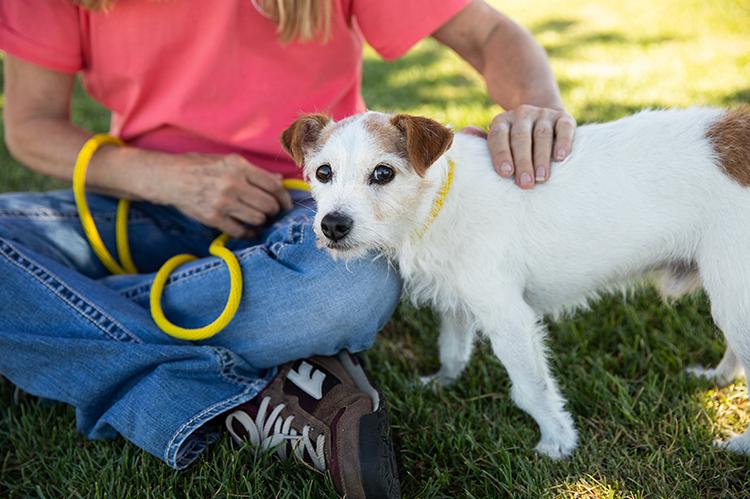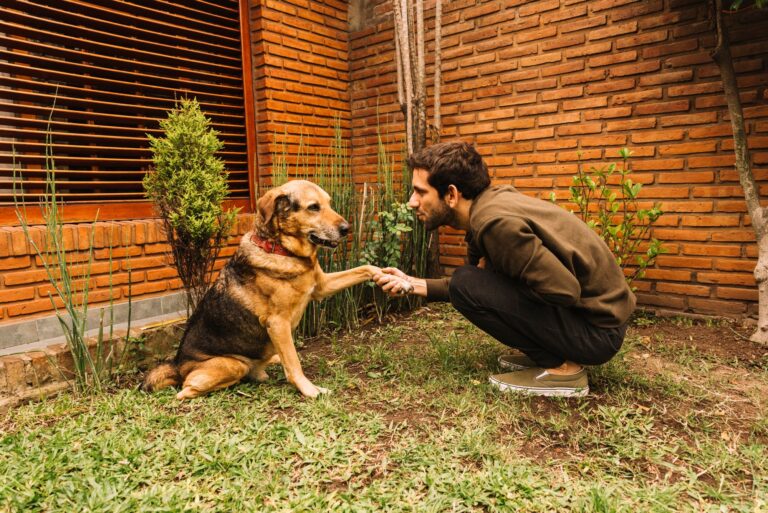To gain the trust of a scared dog, provide a calm and patient environment, using positive reinforcement techniques and allowing the dog to approach you at their own pace. Introducing yourself to a scared dog can be a delicate process, as their fear may cause them to be untrusting or anxious.
By following some simple guidelines, you can help a scared dog to gradually build trust in you and create a bond based on patience and understanding. It’s important to create a calm and secure environment, free from loud noises or sudden movements, to ensure the dog feels safe.
Using positive reinforcement techniques, such as treats or toys, can help to form positive associations with your presence. Additionally, allowing the dog to approach you at their own pace can help them feel more in control and therefore more comfortable. With time and consistency, you can gain the trust of a scared dog and provide them with the love and care they deserve.

Credit: www.cell.com
Understanding The Mindset Of A Scared Dog
Understanding the mindset of a scared dog is crucial to gaining their trust. Discover effective strategies to help a frightened dog feel safe and secure in your presence. Build a strong bond through patience, empathy, and positive reinforcement techniques.
Recognizing Signs Of Fear
The first step towards gaining the trust of a scared dog is understanding their mindset. Dogs exhibit various signs when they are feeling scared or anxious. Recognizing these signs will help you determine how to approach and interact with them in a way that encourages trust. Some common signs of fear include:
- Tail tucked between the legs
- Lowered body posture
- Pinned-back ears
- Avoidance of eye contact
- Excessive panting or trembling
- Excessive shedding or raised fur
- Yawning or lip licking
By being observant and attuned to these signs, you can assess the level of fear your dog is experiencing and adjust your approach accordingly.
Identifying The Source Of Fear
In order to help a scared dog trust you, it is crucial to identify the source of their fear. Dogs can be scared of specific triggers or have generalized anxiety. Common sources of fear include:
- Previous traumatic experiences
- Limited socialization during the early stages of life
- Unfamiliar environments or objects
- Loud noises, such as thunderstorms or fireworks
- Physical pain or discomfort
Knowing the specific source of your dog’s fear can guide your efforts in creating a supportive environment for them.
Building Empathy With The Dog
Empathy is key when it comes to gaining the trust of a scared dog. Putting yourself in their paws and understanding their emotions is essential. Here are some strategies for building empathy:
- Approach the dog calmly and gently.
- Avoid sudden movements or loud noises that may startle them.
- Use positive reinforcement techniques, such as treats and praise, to reward them for calm behavior.
- Give the dog space and time to adjust to new situations.
- Establish a consistent routine to provide them with a sense of security.
- Seek professional help from a veterinarian or animal behaviorist if needed.
Remember, building trust with a scared dog takes time and patience. Consistency, understanding, and empathy will go a long way in helping them overcome their fears and develop trust in you as their caregiver.
Creating A Safe And Calm Environment
Gain the trust of a fearful dog by creating a safe and peaceful environment. Establish a calm presence and use positive reinforcement to build a bond and alleviate their anxiety.
Creating a Safe and Calm Environment When it comes to gaining the trust of a scared dog, creating a safe and calm environment is essential. Dogs that have experienced trauma or abuse may have difficulty trusting humans again, making it important to create an environment that makes them feel safe and secure. In this article, we will explore three key steps to help you create such an environment: providing a secure space, minimizing noise and sudden movements, and establishing a routine. ## Providing a Secure Space To help a scared dog regain trust, it is crucial to provide them with a secure space where they can feel protected. This could be a designated area in your home, such as a crate or a quiet room, where they can retreat to when they feel overwhelmed or frightened. Ensure that this space is comfortable, with soft bedding and familiar objects that carry their scent. By having a secure space, your dog will have a place where they can relax and feel safe, allowing them to gradually build trust. ## Minimizing Noise and Sudden Movements Scared dogs are often sensitive to loud noises and sudden movements. To create a calm environment, it is important to minimize such stimuli. Keep the volume of your TV or music low, avoid slamming doors or using noisy appliances, and limit the number of visitors in your home. By reducing noise and sudden movements, you will create an atmosphere of tranquility that will aid in gaining your dog’s trust. ## Establishing a Routine Dogs thrive on routine, and establishing one can greatly help a scared dog to feel secure. Set consistent mealtimes, exercise routines, and regular play sessions. This predictable schedule will provide your dog with a sense of stability and reassurance, leading to increased trust over time. Be patient and consistent with the routine, as it will help your dog feel comfortable and begin to trust that their needs will be met. In conclusion, creating a safe and calm environment is crucial when working towards gaining the trust of a scared dog. Providing a secure space, minimizing noise and sudden movements, and establishing a routine are vital steps towards helping your furry friend feel safe and secure once again. Remember to be patient and understanding, as trust takes time to build. With a little effort and a lot of love, you can create an environment where your scared dog can learn to trust and thrive.Gradual Desensitization And Positive Reinforcement
To gain the trust of a scared dog, gradual desensitization and positive reinforcement are key. By slowly exposing the dog to fearful stimuli and rewarding calm behavior, you can help them build confidence and trust in you.
Introducing Positive Associations
To help a scared dog trust you, it is crucial to establish positive associations between yourself and the dog. You want the dog to associate you with positive experiences, creating a sense of safety and comfort.
Start by offering the dog high-value treats, such as small pieces of cooked chicken or cheese, whenever you are around. This will help the dog develop a positive association with your presence. Be patient and avoid making sudden movements or loud noises that might startle the dog.
Additionally, spend time near the dog without trying to touch or interact with it. Sit or lie down nearby, engaging in calm and non-threatening activities. This helps the dog realize that your presence does not pose a threat and can promote trust and relaxation.
Using Treats And Rewards
Treats and rewards are powerful tools in gaining a scared dog’s trust. By using these positive reinforcements, you can demonstrate to the dog that good things happen when they interact with you.
First, you can start by rewarding the dog for small, positive behaviors. For instance, when the dog approaches you willingly or shows signs of relaxation, reward them immediately with a treat. This reinforces the notion that being near you leads to good things.
Moreover, it is important to use treats strategically. Only reward the dog when they display the desired behavior, such as approaching you without fear or allowing you to touch them. This helps the dog understand what behavior is expected and encourages them to continue trusting you.
Implementing Desensitization Techniques
Gradual desensitization is a technique that involves gradually exposing the dog to situations or stimuli that trigger fear or anxiety. By doing this in a controlled and systematic manner, you can help the dog overcome their fears and learn to trust you.
One effective way to implement desensitization is to gradually introduce the dog to things that scare them. For example, if the dog is afraid of loud noises, start by playing a recording of the noise at a very low volume. Gradually increase the volume over multiple sessions, always ensuring that the dog remains calm and relaxed throughout.
| Desensitization Process | Step |
|---|---|
| Step 1: | Expose the dog to a mild version of the fear-inducing stimulus. |
| Step 2: | Continue exposing the dog to slightly more intense versions of the stimulus. |
| Step 3: | Reward the dog with treats and praise for remaining calm and relaxed during the exposure. |
| Step 4: | Repeat the process, gradually increasing the intensity until the dog is no longer fearful. |
Remember, desensitization requires patience and consistency. Each dog is unique, and the duration of the process may vary. It is important to always work at the dog’s pace and ensure they feel safe throughout the process.
By utilizing gradual desensitization and positive reinforcement methods, you can start to build trust with a scared dog. Through introducing positive associations, using treats and rewards strategically, and implementing desensitization techniques, you can help the dog overcome their fears and develop a strong bond of trust with you.

Credit: resources.bestfriends.org

Credit: cbddoghealth.com
Frequently Asked Questions For How To Get A Scared Dog To Trust You
How Long Does It Take A Scared Dog To Trust You?
It can take a scared dog different lengths of time to trust you, depending on the individual dog’s experiences and temperament. Some dogs may warm up quickly, while others may take weeks or even months to build trust. Be patient, consistent, and gentle to help build trust with your scared dog.
How Do You Bond With A Dog That Is Scared Of You?
To bond with a scared dog, be patient, show calmness, and give them space. Slowly introduce yourself with treats and toys, maintain a regular routine, and engage in positive activities together. Offer gentle touches and avoid sudden movements or loud noises.
Build trust over time.
How Do You Reassure A Scared Dog?
To reassure a scared dog, provide a calm and safe environment. Speak in soothing tones and avoid making sudden movements. Offer treats or toys as positive reinforcement. Give them space and time to adjust, and consider seeking professional help if their fear persists.
How Do You Get A Skittish Dog To Come To You?
To get a skittish dog to come to you, be patient and gentle. Approach slowly using a calm tone of voice, avoiding sudden movements. Use treats or toys as positive reinforcement. Give them space and time to get comfortable and build trust.
Conclusion
Gaining the trust of a scared dog is a gradual process that requires patience and understanding. By creating a safe and calm environment, using positive reinforcement techniques, and giving the dog space and time to adjust, you can build a strong bond of trust.
Remember to be consistent with your approach and allow the dog to set the pace. With dedication and love, you can help your furry friend overcome their fears and experience a happy and fulfilling life.



